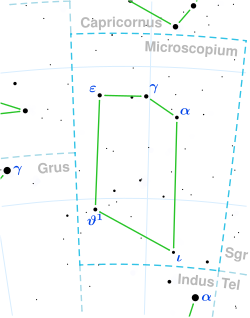Beta Microscopii
| Observation data Epoch J2000.0 Equinox J2000.0 (ICRS) | |
|---|---|
| Constellation | Microscopium |
| Right ascension | 20h 51m 58.7618s[1] |
| Declination | −33° 10′ 40.7051″[1] |
| Apparent magnitude (V) | 6.05±0.01[2] |
| Characteristics | |
| Spectral type | A1 IV[3] |
| B−V color index | +0.03[4] |
| Astrometry | |
| Radial velocity (Rv) | −12±4.3[5] km/s |
| Proper motion (μ) | RA: +7.712 mas/yr[1] Dec.: −5.568 mas/yr[1] |
| Parallax (π) | 6.5022 ± 0.0451 mas[1] |
| Distance | 502 ± 3 ly (154 ± 1 pc) |
| Absolute magnitude (MV) | +0.22[6] |
| Details | |
| Mass | 2.96[7] M☉ |
| Radius | 3.5±0.1[8] R☉ |
| Luminosity | 77.25[6] L☉ |
| Surface gravity (log g) | 3.58[9] cgs |
| Temperature | 8,942[10] K |
| Metallicity [Fe/H] | 0.00[11] dex |
| Rotational velocity (v sin i) | 275±3[12] km/s |
| Age | 337[11] Myr |
| Other designations | |
| Database references | |
| SIMBAD | data |
Beta Microscopii (Beta Mic), Latinized from β Microscopii, is a solitary star in the constellation Microscopium. It is close to the lower limit of stars that are visible to the naked eye having an apparent visual magnitude of 6.05[2] Based upon an annual parallax shift of 6.5022 mas as seen from Earth,[1] this star is located 502 light years away[1] from the Sun. At that distance, the visual magnitude is diminished by an extinction factor of 0.19 due to interstellar dust.[11]
Beta Mic has a stellar classification of A1 IV,[3] indicating that it is an evolved A-type subgiant. Older sources give it a class of A2 Vn,[15] suggesting that it is an A-type main-sequence star with nebulous absorption lines due to rapid rotation. Consistent with the older classification, the star is spinning rapidly with a projected rotational velocity of 275 km/s.[12] The star has 2.96 times the mass of the Sun[7] and due to its evolved status, has a radius of 3.5 R☉.[8] It radiates at 77.2 times the luminosity of the Sun[6] from its photosphere at an effective temperature of 8,942 K,[10] giving a white hue. Beta Mic has a solar metallicity and is estimated to be around 340 million years old.[11]
References
[edit]- ^ a b c d e f Brown, A. G. A.; et al. (Gaia collaboration) (2021). "Gaia Early Data Release 3: Summary of the contents and survey properties". Astronomy & Astrophysics. 649: A1. arXiv:2012.01533. Bibcode:2021A&A...649A...1G. doi:10.1051/0004-6361/202039657. S2CID 227254300. (Erratum: doi:10.1051/0004-6361/202039657e). Gaia EDR3 record for this source at VizieR.
- ^ a b Høg, E.; Fabricius, C.; Makarov, V. V.; Urban, S.; Corbin, T.; Wycoff, G.; Bastian, U.; Schwekendiek, P.; Wicenec, A. (March 2000). "The Tycho-2 catalogue of the 2.5 million brightest stars". Astronomy and Astrophysics. 355: L27 – L30. Bibcode:2000A&A...355L..27H. ISSN 0004-6361.
- ^ a b Houk, N. (1982). Michigan Catalogue of Two-dimensional Spectral Types for the HD stars. Volume_3. Declinations -40_ƒ0 to -26_ƒ0. Bibcode:1982mcts.book.....H.
- ^ Corben, P. M.; Stoy, R. H. (1968), "Photoelectric Magnitudes and Colours for Bright Southern Stars", Monthly Notes of the Astronomical Society of Southern Africa, 27: 11, Bibcode:1968MNSSA..27...11C.
- ^ Gontcharov, G. A. (November 2006), "Pulkovo Compilation of Radial Velocities for 35 495 Hipparcos stars in a common system", Astronomy Letters, 32 (11): 759–771, arXiv:1606.08053, Bibcode:2006AstL...32..759G, doi:10.1134/S1063773706110065, S2CID 119231169.
- ^ a b c Anderson, E.; Francis, Ch. (May 2012). "XHIP: An extended hipparcos compilation". Astronomy Letters. 38 (5): 331–346. arXiv:1108.4971. Bibcode:2012AstL...38..331A. doi:10.1134/S1063773712050015. ISSN 1063-7737. S2CID 119257644.
- ^ a b Kervella, Pierre; Arenou, Frédéric; Thévenin, Frédéric (2022). "Stellar and substellar companions from Gaia EDR3". Astronomy & Astrophysics. 657: A7. arXiv:2109.10912. Bibcode:2022A&A...657A...7K. doi:10.1051/0004-6361/202142146. eISSN 1432-0746. ISSN 0004-6361.
- ^ a b Stassun, Keivan G.; et al. (9 September 2019). "The Revised TESS Input Catalog and Candidate Target List". The Astronomical Journal. 158 (4): 138. arXiv:1905.10694. Bibcode:2019AJ....158..138S. doi:10.3847/1538-3881/ab3467. ISSN 0004-6256.
- ^ Steinmetz, Matthias; et al. (27 July 2020). "The Sixth Data Release of the Radial Velocity Experiment (Rave). II. Stellar Atmospheric Parameters, Chemical Abundances, and Distances". The Astronomical Journal. 160 (2): 83. arXiv:2002.04512. Bibcode:2020AJ....160...83S. doi:10.3847/1538-3881/ab9ab8. eISSN 1538-3881.
- ^ a b Anders, F.; et al. (February 2022). "Photo-astrometric distances, extinctions, and astrophysical parameters for Gaia EDR3 stars brighter than G = 18.5". Astronomy & Astrophysics. 658: A91. arXiv:2111.01860. Bibcode:2022A&A...658A..91A. doi:10.1051/0004-6361/202142369. eISSN 1432-0746. ISSN 0004-6361.
- ^ a b c d Gontcharov, G. A. (December 2012). "Dependence of kinematics on the age of stars in the solar neighborhood". Astronomy Letters. 38 (12): 771–782. arXiv:1606.08814. Bibcode:2012AstL...38..771G. doi:10.1134/S1063773712120031. ISSN 0320-0108. S2CID 255201789.
- ^ a b Díaz, C. G.; González, J. F.; Levato, H.; Grosso, M. (July 2011). "Accurate stellar rotational velocities using the Fourier transform of the cross correlation maximum". Astronomy & Astrophysics. 531: A143. arXiv:1012.4858. Bibcode:2011A&A...531A.143D. doi:10.1051/0004-6361/201016386. eISSN 1432-0746. ISSN 0004-6361.
- ^ Gould, Benjamin Apthorp (1878). "Uranometria Argentina : brillantez y posicion de las estrellas fijas, hasta la septima magnitud, comprendidas dentro de cien grados del polo austral : con atlas". Resultados del Observatorio Nacional Argentino. 1. Bibcode:1879RNAO....1.....G.
- ^ "bet Mic". SIMBAD. Centre de données astronomiques de Strasbourg. Retrieved 2017-08-14.
{{cite web}}: CS1 maint: postscript (link) - ^ Evans, D. S. (1966). "Fundamental data for Southern stars (6th list)". Royal Greenwich Observatory Bulletins. 110: 185. Bibcode:1966RGOB..110..185E.

